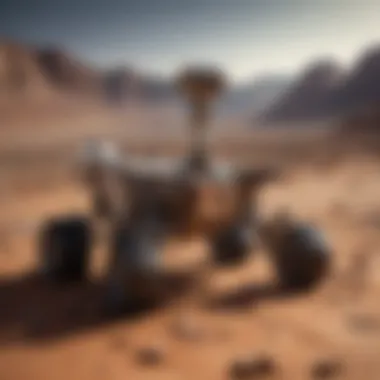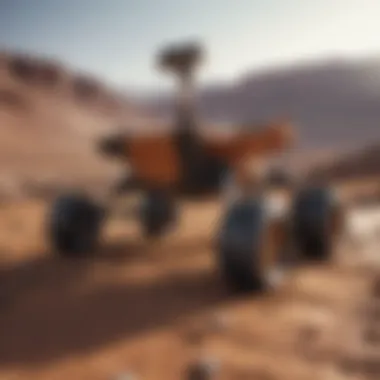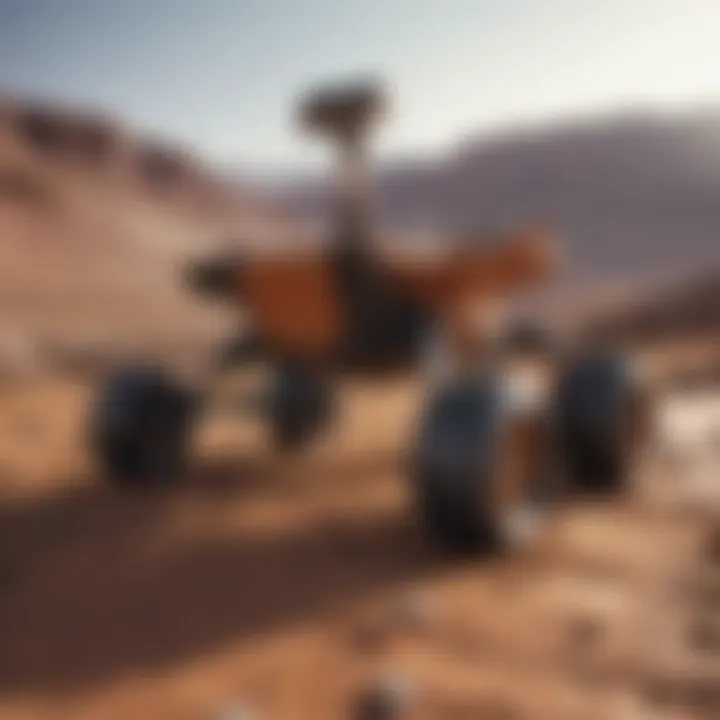The Evolution and Impact of Mars Rovers


Intro
The exploration of Mars has become a defining element in understanding planetary science. Mars rovers serve as mobile laboratories that gather data about the Martian environment, geology, and potential for life. This article examines their evolution over time, from initial designs to the sophisticated machines used today. The impact of these rovers on scientific understanding and international collaboration is undeniable.
Research Overview
Key Findings
- Advancements in Technology: Each rover mission has built on the successes and learnings of previous missions. Innovations in robotics, sensors, and autonomous navigation have significantly improved data collection capabilities.
- Scientific Contributions: Missions like Opportunity and Curiosity have provided crucial insights into Mars' atmosphere, surface composition, and historical climate. Their findings enhance our understanding of the planet's capacity to support life.
- International Collaboration: Missions involve multiple nations and organizations, fostering a spirit of cooperative exploration. This collaboration maximizes resources and expertise, essential for mission success.
Study Methodology
This analysis draws from a range of sources, including mission reports, scholarly articles, and data from NASA and international space agencies. Interviews with scientists involved in past missions have also informed this examination.
Background and Context
Historical Background
The journey of Mars exploration began with flyby missions in the 1960s. However, it was not until the launch of the Sojourner rover in 1997 that rovers played a significant role in Mars studies. This mission showcased the potential for mobile exploration.
Current Trends in the Field
Today’s Mars rovers, including Perseverance and the Ingenuity helicopter, represent the forefront of robotic space exploration. These missions focus not only on geological aspects but also on astrobiology. Increased emphasis is placed on preparing for future human missions, making current trends vital for long-term exploration goals.
Mars rovers continue to redefine our understanding of the Red Planet and our potential future on it. Their evolution reflects advancements in technology and international cooperation, paving the way for new discoveries.
Preamble to Mars Exploration
Exploring Mars is a quest that has fascinated humanity for decades. The implications of understanding a neighboring planet are profound, serving not only technological advancement but also unraveling the mysteries of our own existence. Mars has long captured the imaginations of scientists, researchers, and enthusiasts. This section will examine the foundational importance of Mars exploration, especially through the lens of robotic missions, highlighting the key aspects that underscore its significance.
Historical Overview of Mars Rovers
A historical overview of Mars rovers illuminates the advancements made since the early days of space exploration. The journey began with the Viking program, which sent two landers to Mars in the 1970s. Although they did not possess roving capabilities, these missions laid the groundwork for future explorations. Following that, the Sojourner rover emerged in 1997, marking the first time a rover traversed the Martian surface. Its small size and rudimentary technology exemplified the challenges of early missions.
The twin rovers, Spirit and Opportunity, launched in 2003, represented a significant leap in robotic technology. They operated far beyond their expected lifespan, leading to unprecedented discoveries. Curiosity, which landed in 2012, introduced more advanced tools for scientific analysis, such as a drill and a suite of laboratory instruments. Perseverance, launched in 2020, continues this legacy by not only seeking signs of ancient life but also testing technology for future human missions.
Significance of Robotic Exploration
The significance of robotic exploration cannot be overstated. Mars rovers serve multiple critical roles. First, they reduce risks associated with human exploration by allowing scientists to access hostile environments remotely. By collecting data and conducting experiments on-site, these machines gather invaluable information that informs our understanding of planetary science and astrobiology.
Moreover, rovers conduct tests for future human presence. They assess terrain, identify resources, and analyze Martian soil and atmosphere. This data aids in planning sustainable missions, laying the groundwork for what may one day become human habitation.
Robotic missions also inspire global collaboration. Different countries and organizations contribute knowledge, technology, and funding, fostering an environment of shared goals in the quest for knowledge about Mars. This international cooperation enhances the research landscape and expands the horizons of what is achievable.
"Robotic exploration of Mars is not just a technical endeavor; it reflects humanity's enduring desire to understand its place in the universe."
Key Missions in Mars Rover History
The history of Mars rover missions is a critical lens through which to view the progress of our understanding of the Red Planet. Each mission signifies a leap forward in technological capabilities, allowing science to investigate Mars in ways previously unimaginable. The missions often build on each other’s successes and failures, culminating in an expanding knowledge base that informs future explorations.
Key missions have not only advanced engineering and design but also expanded our comprehension of Mars’ geology, atmosphere, and potential for life. These early explorations reveal the harsh realities of Mars, paving the way for more sophisticated missions.
"The Mars rovers act as our eyes and hands on the Martian surface, providing insights that are impossible to achieve from afar. Each mission has its own story and its own lessons learned."
Sojourner: The First Mars Rover


Sojourner was humanity's first true representation of robotic exploration on the Martian soil. Launched in December 1996, it landed on Mars in July 1997. Operating as part of NASA's Mars Pathfinder mission, Sojourner demonstrated the feasibility of mobility on another planet. The rover measured about 10 inches long and weighed just about 24 pounds. Its primary mission was to analyze the Martian rocks and soil and relay data back to Earth.
The success of Sojourner proved that rovers could navigate and conduct scientific experiments, allowing scientists and engineers to test concepts that would later be expanded upon in future missions.
Spirit and Opportunity: Twin Pioneers
The Mars Exploration Rovers, Spirit and Opportunity, launched in 2003, set new standards in exploration and scientific return. Each rover was expected to operate for 90 Martian days; instead, they exceeded expectations. Spirit operated until 2010, and Opportunity continued until mid-2018. They were equipped with sophisticated instrumentation that allowed for diverse geological surveys, making pivotal discoveries about water presence in the past.
This duo's findings offered substantial evidence of a more temperate, wetter Mars billions of years ago, indicating that the planet may have once harbored conditions more suitable for life.
Curiosity: The Game Changer
Curiosity represents perhaps the most significant leap in rover technology. Launched in November 2011, it landed on Mars in August 2012. Curiosity is much larger and equipped with a suite of advanced tools, including a drill, chemical analysis laboratory, and high-resolution camera.
Curiosity’s mission has focused on understanding Mars’ habitability, studying its atmosphere, geology, and the presence of organic compounds. The rover’s findings have provided crucial insights into ancient environments that could have supported microbial life.
Perseverance: The Latest Frontier
Perseverance, which landed on Mars in February 2021, builds on the legacy of previous missions. This rover carries the most advanced technology to date, including the ability to collect and store rock samples for future return missions. It is studying the Jezero Crater, which is believed to be a former lakebed and may offer clues regarding ancient life.
Moreover, Perseverance is equipped with the MOXIE experiment, which aims to convert carbon dioxide from the Martian atmosphere into oxygen, which can be crucial for future human exploration.
In summary, the key missions in Mars rover history demonstrate a progression of technological innovation and scientific inquiry. Each rover's accomplishments strengthen our collective understanding of Mars, contributing towards the overarching goal: to find evidence of life beyond Earth.
Technological Advancements in Rover Design
The design of Mars rovers has evolved significantly since the first successful deployments, and this evolution is critical to the success of planetary exploration. Each advancement in technology not only enhances the capability of rovers but also expands the scientific potential of missions to Mars. Technological advancements improve the efficiency, durability, and effectiveness of rovers, allowing them to accomplish ambitious scientific goals. Understanding these advancements can provide insight into future missions and the overall trajectory of extraterrestrial exploration.
Engineering Innovations
Engineering innovations have played a pivotal role in the development of Mars rovers. The shift from simple mechanical devices to sophisticated, computer-controlled systems has drastically changed rover design. For example, the recent rovers employ advanced materials that offer resilience against harsh Martian conditions. These materials must withstand dust storms, extreme temperatures, and radiation, which means that their selection and application are paramount.
Moreover, improvements in data processing capabilities enable rovers to make real-time decisions. This autonomy not only enhances their exploration efficiency but also allows for more complex scientific experiments. Real-time data analysis permits instant adjustments to research plans based on the information retrieved during the mission.
Power Systems and Energy Management
Managing energy resources remains one of the primary challenges for Mars rovers. The use of solar panels has been instrumental since the earliest models, such as Sojourner. However, newer rovers, like Curiosity and Perseverance, utilize radioisotope thermoelectric generators (RTGs). RTGs provide a constant power supply, crucial for long-duration missions, regardless of sunlight availability.
Efficient energy management systems are essential for optimizing rover performance. These systems balance energy consumption with the rover's operational needs and scientific objectives. Innovations in battery technology further enhance energy storage, directly influencing how long a rover can remain operational. This energy stability is important for continuous monitoring of Martian conditions and for carrying out complex experimental setups without interruption.
Mobility and Navigation Systems
The ability of a rover to navigate the Martian terrain is fundamental to its success in scientific exploration. Advances in mobility and navigation systems have made it possible for rovers to traverse more varied landscapes. Modern rovers are equipped with advanced wheels that can adapt to challenging surfaces, reducing the risk of becoming stuck.
Additionally, sophisticated navigation systems utilize visual data from cameras and LIDAR to create detailed maps of the surrounding terrain. This spatial awareness allows them to avoid obstacles and choose optimal paths. Enhanced mobility not only improves efficiency but increases the area of exploration, allowing scientists to study more diverse geological formations and surface features.
Important Insight: Mobility and navigation are not just about movement; they are essential for data collection and scientific discovery.
In summary, advancements in rover design encompass a wide array of technological improvements that significantly impact Mars exploration. From engineering innovations to power management and navigation, each element contributes to enhancing the overall capabilities of rovers, allowing them to effectively perform their scientific missions and transform our understanding of Mars.
Scientific Contributions of Mars Rovers
The scientific contributions of Mars rovers have profoundly shaped our understanding of the red planet. Each mission provides a unique perspective, offering valuable insights into the geology, potential for life, and climate of Mars. Through sophisticated instruments and ground-breaking technology, these rovers have enabled scientists to gather data that was once beyond reach. This section outlines the key contributions of these missions, particularly in analyzing Martian soil and rocks, searching for water and evidence of past life, and studying weather and atmospheric conditions.
Analysis of Martian Soil and Rocks
Mars rovers are equipped with advanced analytical tools to study Martian soil and rock samples. These tools include spectrometers, cameras, and drilling instruments that help in the collection and examination of geological materials. The analysis of soil and rocks is crucial because it reveals the planet's history and its structural composition.


Sojourner, the first rover, provided initial data on the Martian surface, paving the way for future discoveries. Curiosity utilized its drill and analytical suite to study sedimentary rocks, suggesting that ancient lakes may have existed. The findings highlight various mineral compositions, such as clays and carbonates, pointing to past environmental conditions.
"Examination of Martian geology has unveiled clues about the planet's past climate and habitability potential."
The data gathered from these analyses enhances our knowledge of volcanism, erosion, and sedimentation processes on Mars. This information is key to reconstructing the planet's past, assessing its evolution over millions of years.
Search for Water and Past Life
Finding water is fundamental to understanding Mars' potential for supporting life. Rovers like Spirit and Opportunity sought evidence of past water activity, leading to groundbreaking discoveries. Their findings showcased hematite, a mineral often formed in watery environments, indicating that conditions were once suitable for life.
Curiosity further advanced this exploration by confirming the presence of ancient riverbeds and lakebeds. Its data suggests that the planet had liquid water, crucial for microbial life. Perseverance continues this search, equipped with technology to analyze soil samples that may contain biosignatures.
The search for water is not only about direct evidence but also involves understanding the current conditions. The presence of water ice at the poles and within the subsurface has significant implications for future human exploration and habitation.
Weather and Atmospheric Studies
Mars rovers also play a vital role in studying weather and atmospheric conditions. Understanding Mars' atmosphere is essential in comprehending its climate system and the challenges faced by future missions. The rovers are equipped with sensors to monitor wind, temperatures, and dust storms, gathering continuous data over time.
Curiosity's weather station, for instance, provides real-time weather data that helps scientists assess climatic variations. This data is invaluable, offering insights into seasonal changes, temperature fluctuations, and global dust storms.
Perseverance is building on this foundation, with instruments designed to analyze how Martian dust interacts with the atmosphere, an important aspect in planning future human missions. By studying these environmental factors, scientists gain a better understanding of Mars’ habitability and its dynamic climate.
Each of these scientific contributions significantly improves our grasp of Mars. The ongoing investigations by rovers reveal layers of complexity regarding the planet’s geology, potential for life, and atmospheric dynamics. Together, they create a comprehensive picture, transforming how we view Mars as a key player in our solar system.
International Collaboration in Mars Missions
International collaboration in Mars missions is a critical factor that has shaped the landscape of planetary exploration. The joint efforts of various space agencies have resulted in a wealth of data, advancements in technology, and a broader understanding of Mars and its potential to support life. Such partnerships enable countries to pool resources, share expertise, and reduce the risks associated with ambitious exploration projects.
One of the key benefits of international collaboration is the diversification of technological approaches. Different space agencies bring unique perspectives and methodologies, which can lead to innovative solutions for complex engineering challenges. For instance, NASA's partnerships with the European Space Agency (ESA) have led to the inclusion of new instruments with varied functionalities, expanding the capabilities of Mars rovers.
Moreover, collaboration enhances the scientific output of missions. With contributions from multiple institutions, data can be analyzed in various contexts. This interdisciplinary approach allows for a more comprehensive understanding of the Martian environment, minerals, and possible signs of past life. As researchers from different backgrounds come together, they bring fresh viewpoints that may challenge existing assumptions and lead to groundbreaking discoveries.
Partnerships Between Space Agencies
Partnerships between space agencies are crucial for successful Mars missions. NASA's Spirit and Opportunity rovers, for example, benefited from international cooperation through instruments developed in collaboration with universities and institutions worldwide. These partnerships not only facilitate resource sharing but also foster goodwill and strengthen diplomatic ties.
Agencies such as the CNSA (China National Space Administration), ISRO (Indian Space Research Organisation), and Roscosmos (Russian Federal Space Agency) are making strides in Mars exploration. Collaborative efforts among these organizations can streamline the planning, execution, and scientific analysis of missions.
Some notable partnerships include:
- NASA and ESA: Collaboration on the ExoMars program aims to deliver sophisticated scientific equipment and enhance the search for life on Mars.
- Mars Sample Return Mission: Involving multiple agencies, this mission exemplifies how partnerships can transform ambitious concepts into reality, pooling knowledge and finances.
Impact of Collaborative Research
Collaborative research stemming from international missions has profound implications for our understanding of Mars and beyond. By combining findings from multiple sources, scientists can build a more detailed picture of the planet’s geology, climate, and potential for supporting life.
"International collaboration is not just a matter of pooling resources; it represents a united pursuit of knowledge that can significantly advance humanity's understanding of our place in the universe."
Some key impacts of collaborative research are:
- Broader Focus Areas: Joint missions encourage researchers to explore a wider range of scientific questions, enhancing the quality and scope of conclusions drawn.
- Increased Data Accessibility: Data gathered during missions is often shared openly among countries, providing valuable information for academic research and public interest.
- Fostering Young Talent: International missions often involve training programs, encouraging young scientists and engineers to collaborate and innovate.
In summary, international collaboration in Mars missions has proven fundamental to expanding our knowledge and understanding of Mars. As countries continue to unite for exploration, the future holds promising potential for even greater breakthroughs.
Challenges in Mars Rover Missions
The exploration of Mars through robotic rovers has revolutionized our understanding of the red planet. However, the path to achieving successful missions is fraught with numerous challenges. Understanding these challenges helps in grasping the complexities involved in Mars exploration and highlights the technological and environmental considerations that must be addressed.


Technical and Engineering Hurdles
Every Mars rover mission is a colossal engineering feat. From design to deployment, engineers face multiple technical challenges. One significant hurdle is the harsh Martian environment. Temperatures can plunge to extreme lows, plunging to -195 degrees Fahrenheit in the poles. Such conditions necessitate rigorous testing of materials and components to ensure they can withstand these temperatures. Additionally, rovers must survive dust storms that can last for months. The dust can clog mechanical parts, block solar panels, and hinder communication.
Another challenge is the distance between Earth and Mars. The signals sent to and from Earth face a delay of anywhere between 3 to 22 minutes, depending on the planets' positions. This factor complicates control, making real-time operation impossible. Engineers often design autonomous systems that can make decisions without immediate input from mission control. This adds complexity to the rover's software and hardware architectures.
Power systems also pose significant challenges. Rovers must operate for prolonged periods without a constant supply of power. For instance, the Curiosity rover uses a radioisotope thermoelectric generator, which converts heat from radioactive decay into electrical energy. However, the initial guidance systems must be reliable from the start, indicating a fine line between innovation and risk.
Environmental Risks on Mars
Mars presents a myriad of environmental risks that complicate mission planning. The planet's thin atmosphere is largely composed of carbon dioxide and lacks the protective magnetic field earth possesses, making the rovers vulnerable to radiation. This radiation can damage delicate electronic systems and impede scientific measurements. The engineering decisions around shielding these components require balance between weight, cost, and protection.
Furthermore, the terrain on Mars is another substantial risk. The rovers must traverse a surface that includes rocks, craters, and dust fields. Mobility systems must be robust enough to handle these obstacles without getting stuck or damaged. Each rover is equipped with sophisticated navigation systems to help avoid hazardous terrain, but the unpredictability of Martian geology often presents unforeseen challenges.
"The success of Mars rover missions hinges on overcoming both technical and environmental challenges, which demand innovative solutions and adaptive strategies."
Understanding these challenges not only informs future rover designs, but it also provides insights critical for planning potential human missions to Mars. Each success and failure offers valuable lessons for the broader field of planetary exploration, underlining the need for continued advancement in technology and engineering practices.
The Future of Mars Exploration
The exploration of Mars encapsulates humanity's quest for knowledge beyond our planet. As we build on the foundations laid by earlier missions, the future of Mars exploration is not just about reaching the red planet, but understanding it at a deeper level. This section will address the planned missions along with innovative concepts that will shape our strategies going forward, and the prospects for human colonization that challenge our technical capabilities and ethical considerations.
Planned Missions and Concepts
The coming years will see a surge in ambitious planned missions to Mars. Notable projects include NASA's Artemis program, which aims to establish a presence on the Moon as a stepping stone for Mars missions. This framework will facilitate the development and testing of technologies that will be critical for the long journey to Mars. Additionally, the Mars Sample Return mission is currently in development, aiming to bring back samples from the Martian surface for detailed analysis on Earth.
Other countries are also stepping up their involvement. The European Space Agency plans to collaborate with NASA on the Mars Sample Return and develop ExoMars, which should enhance our understanding of Martian life potential.
Conceptual missions such as “Mars Base Camp” envision sustained human presence on Mars. Innovations include:
- Next-generation rovers equipped with advanced AI for autonomous navigation.
- habitats designed to support human life with closed-loop life support systems.
- communication networks to ensure continuous contact with Earth.
These missions place emphasis on sustainability and adaptability, as conditions on Mars present unique challenges.
Prospects for Human Colonization
Human colonization of Mars remains a multifaceted subject riddled with technical questions and ethical dilemmas. As institutions explore the feasibility of sustained human presence on Mars, various considerations arise. Life support, radiation protection, and sustainable food sources are core challenges that demand solutions.
SpaceX's Starship plays a pivotal role in these prospects. It is designed for deep space missions, capable of carrying humans to Mars. The vision is to establish a self-sustained colony, where individuals can live and work. This requires substantial advancements in:
- Resource utilization to extract water and generate oxygen from Martian materials.
- Ensuring safe transportation and habitat construction with available resources.
Ethically, the question of our responsibility towards extraterrestrial environments is germane. As we embark on colonization, discussions about planetary protection, alien ecosystems, and potential contamination must be considered.
In summary, the future of Mars exploration is dynamic, influenced by technological innovations and collaborations. Planned missions and concepts aim to not only reach Mars but to also foster humanity’s enduring presence and potentially pave the way for interstellar exploration.
Culmination
The discussion of Mars rovers and their impact on planetary science concludes with a recognition of their immense contributions to our knowledge of Mars and by extension, the universe. These missions have not only enhanced our understanding of the Martian landscape but have also paved the way for future explorations, both robotic and human.
Summary of Key Points
In this article, key points include:
- The historical evolution of Mars rovers, showcasing missions from Sojourner to Perseverance.
- Technological advancements that have shaped rover designs, improving their capability to navigate and conduct scientific experiments.
- The significance of international cooperation in achieving mission goals, leading to enhanced scientific outcomes.
- The challenges faced during the missions, including engineering hurdles and environmental risks on Mars.
- The promising future of Mars exploration, including planned missions and the potential for human colonization.
In summary, each section builds on the previous one, illustrating a comprehensive map of Mars exploration.
Implications for Planetary Science
The implications for planetary science are profound. Mars rovers have broadened our understanding of the planet's geology, climate, and potential for past life. They provide invaluable data that helps researchers piece together the planet’s history. Furthermore, findings from rovers like Curiosity and Perseverance are critical in assessing Mars' habitability, influencing both robotic and human missions. Understanding the challenges associated with this exploration offers essential insights for future missions.
As we look to the future, the lessons learned from current and past Mars rover missions inform strategies that will be essential for expanding the boundaries of human knowledge and presence in space. This continuous journey not only enhances our scientific understanding but also stirs curiosity about our place in the cosmos.







